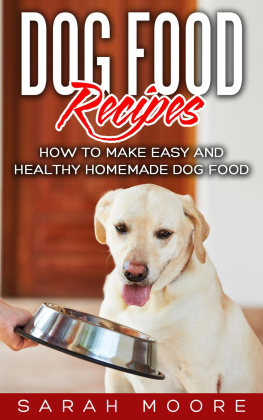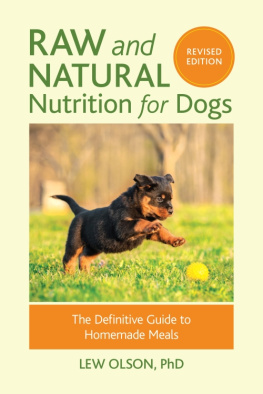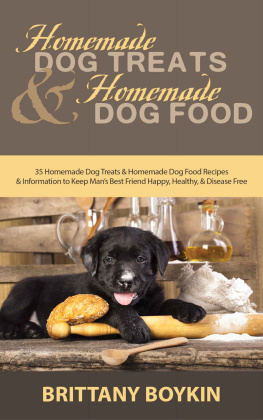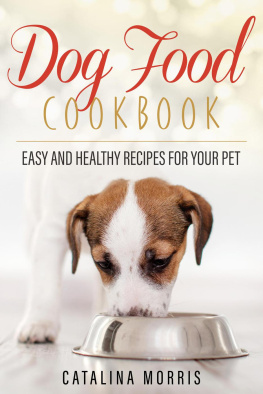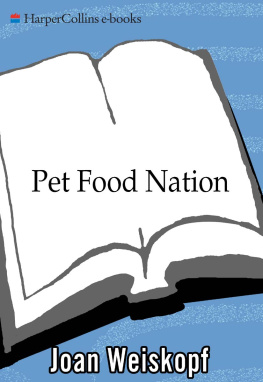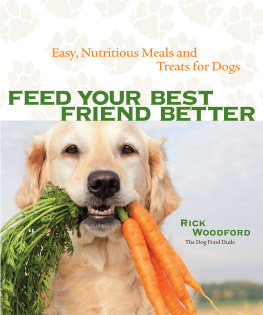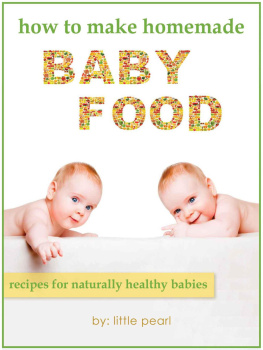Part I: Introduction
My family and I have always loved animals of all types. That meant we had a lot of animals as well and several of them were dogs. As a child and into adulthood I wanted to make sure that my dogs were well taken care of and that they had the best care possible. Its a goal that most everyone has. After all, who doesnt want to take good care of their pets? The problem is that a lot of people adopt pets without really knowing what it takes to look after them properly.
One of the most important things that you need to know about is the nutrition that your dog needs. There are actually a lot of things you want to make sure that your dog is getting and if you arent looking into those things you could be hurting your dog more than you know. If youre feeding your dog just any national, commercial brand dog food off the shelf you could be hurting them as well because not all of those dog foods have the ingredients that your dog actually needs.
Chapter 1: Where Commercial Dog Food Comes From
Commercial dog food had to come from somewhere right? Just like everything else, at one point everyone just made their own and then one day someone decided to start making large quantities and sell it to the public. People who owned dogs before this would often give their pets their own food and table scraps as their meal which led to a lot of unhealthy pets.
Gradually people came to realize that dogs need to have special nutrition as well, just like people do. Otherwise your pets could end up with the same types of illnesses that humans get. Its actually possible for your dog to get hypertension, cancer and diabetes, did you know that? Well if you arent careful its very likely that it could happen to your dog.
Feeding dogs commercial pet food began around World War II. The Baby Boom had occurred and that meant there were a lot more people eating meat around the world. Because meat was being consumed more it needed to be processed even more. But when you process meat there are many byproducts that are created that cant (or wont) be eaten by people. These byproducts however, became the foundation for pet food.
R. Purina created an industrial process to mass produce feed for animals which originally began with hogs and chickens. By creating pellets that could be fed to these animals it was far easier to increase output of the animals. This also helped to get rid of the unusable byproducts of meat production (unusable by humans anyway). After some time the pet food companies began creating food for other animals such as dogs, cats and rabbits as well.
Dry foods use flour and animal meets as well as milk products to create a pellet that your pet can eat. Some also contain added vitamins and minerals to help make them healthier for your pets. If youre looking for more information on the contents of your dogs kibble you can know that it has at least 40% carbs because if it had less than the industrial process currently in use would not work.
The next type of dog food is the semi-moist food. It contains humectants to keep it moist and to keep it from spoiling at the same time. This product is actually a chemical compound which stops chemical processes from occurring that would typically cause spoiling of any kind of moist food product. It also contains ground soybeans and fresh meat. It may also contain some fat.
Finally, we have canned food. There are different types of this food which include rationed dog food (primarily made of meat scraps and internal organs cooked in a high pressure environment that creates a liquid state), all-meat (made of animal tissue and meat byproducts with added preservatives to maintain freshness) and chunky stews.
Did you know that some of the ingredients in your dogs food are put there just for you? Some of the color that appears in the food isnt natural at all and is actually added pigments and artificial colorants which make the food less healthy for your dog. Unfortunately it makes the food look better to you and that means more pet owners purchase it without realizing that they are hurting their pets by doing so.
Chapter 2: Understanding Your Dogs Health
There are many nutrients that your dog, just like you, needs in order to stay healthy. Thats why were going to start out with a focus on those nutrients that will help your dog to continue growing and healing properly. These nutrients will also help them to live longer and to live a happier and healthier life as well. Your dog will definitely thank you for listening to their health care needs.
Chapter 3: All About Protein
Any mammal in the world needs protein in order to grow and repair their body. It also helps to regulate other important biological processes. This means that it is essential to include in your dogs diet. It also means you must avoid too high carbs in exchange for that great protein. Make sure youre giving them plenty of protein especially when they are first weaned and when they are still young and growing.
On the other hand, too much protein can lead to health problems of its own. If you give your dog too much protein it could end up with kidney problems and even kidney failure. If there is too much protein in your dogs diet it may also lead to a change in their temper which means a friendly and happy dog could snap at people.
Chapter 4: What About Fats?
Fats are considered to be the most problematic of all nutrients both for animals and for humans but this is not necessarily the case. Though they are considered to be the worst cause of obesity (which is true) they are also essential to the overall health of yourself and your pets. Too little fat can cause your dog to suffer from kidney problems as well as unhealthy skin and fur.
One of the best healthy fats available for your dog is omega fatty acids which are most prevalent in fish. So make sure youre getting your dog some fish in their diet or at least a supplement with omega fatty acids so that they will get the right amount of fats that they need. Without these fats your dog could end up looking and feeling pretty bad.
Chapter 5: Carbs for Your Dog
In order for your dog to continue being as active as ever you need to make sure they are getting the carbs they need. These carbs turn into energy and that means your dog will need at least 40-50% carbs within their diet.
For regular, commercial dog food there are cheap versions of carbs which are primarily starch. But your dog may have troubles with digesting some types of carbs. For example many dogs show signs of allergies to soybeans. These signs may appear as flatulence or indigestion. If your dog does have this type of allergy then youre going to want to look for a different type of dog food with regular or wheat flour rather than soybean. If you really want to do whats best for your dog then look into the recipes later on.
Chapter 6: Indigestion
Most dog foods that are commercially sold have an absolute minimum of 40% carb content. On the other hand some foods are considered to be light or low-fat but have up to 70% carb content. This means that they are dangerous for your dog and have far too much carb content for a typical dogs diet.
What we would consider ancient diets for dogs would contain approximately 30% carb content which means that your dog doesnt need to get so much carb content from their diet. Remember that dogs are naturally carnivores and that means they have extensive digestive systems that can break down complex proteins. These are whats needed for your dog to continue to have enough energy and biological maintenance.
When dogs have food allergies it can cause them indigestion. On the other hand if they dont have the right number of digestive enzymes or have the wrong types of sugar or carbs in their system. These things can cause enzyme deficiencies and this causes foods to be improperly digested. When the food remains in the digestive tract it begins to ferment and create bacteria. This causes indigestion for the dog which is also affected by several other factors:
Next page

